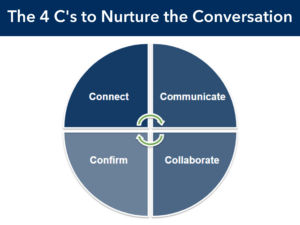Avoid miscommunication and make your interactions more meaningful
When communication is smoother, life is smoother, work is more productive, relationships are stronger. We’ve talked about ways messages miss their mark and offered 5 considerations to avoid miscommunication (check those out here ). And we introduced the 4 C’s as a way to nurture more productive conversations. Now let’s dig into each of the 4 C’s a little deeper with some tips for each stage.

 |
Create an interpersonal connection.
At this stage you are focusing on making a mindful connection with the other person through verbal and non-verbal communications. Verbal refers to what you say and how you say it, no matter the medium (email, face-to-face, phone). Nonverbal is your body language, your expression, and your presence. Even virtually, people can still see your facial expressions, your upper body positioning, and where your eyes are looking.
To create a connection:
- Use video conferencing when you can – Seeing someone’s face on video and having virtual eye contact can help you pick up on nonverbal cues and feel more connected to them.
- Consider your audience – Who they are affects how they might receive the message. What is your relationship? Do you know their temperament? Do you have filters about them? How do you think they will receive the message?
- Actively listen – Show general signs of listening, even when people can’t see you (yes, it does come through in your voice)—leaning forward, head nodding, genuine smiling.
- Be empathetic – Friendly, respectful, dignifying. Go into the conversation without judgmental filters about the person or the conversation so it doesn’t cloud your mind.
- Be your authentic self – People often notice if someone is trying to “fake it,” which can cause distrust or skepticism. Just be yourself!
- Be fully present – Don’t think about what you are going to say next and don’t be doing other work during virtual meetings.
- Be aware of their body language – Are they leaning in, fidgeting, looking away? Is their voice shaky, angry, skeptical?
- Beyond the immediate conversation, keep the lines of communication open to foster connection – Hold regular check-in meetings to strengthen the bonds with and among team members.
|
 |
Clearly communicate your message.
In order for your message to be effectively relayed, you need to be clear, concise, and confident.
- Prepare what you are going to say – Create visuals if appropriate, and practice!
- Know why the message is important – When inviting people to attend, be clear on the topic and what is going to be communicated.
- Know your most important points – Get to the point quickly and emphasize the most important elements.
- Pick the right time and the right length of time – People won’t engage in meetings for hours. Try to plan your session for no more than 30-45 minutes.
- Be aware of your environment and potential distractions – Close your office door. Keep your eyes on the audience (the camera, if virtual). Ask those who aren’t speaking to go on mute.
Also, remember that you have to maintain connection and be in tune with how your message is landing. The moment someone doesn’t think the message is important to them, you have lost engagement. If the audience doesn’t seem connected, what connection points can you go back to to reestablish connection?
|
 |
Build in time for collaboration and listening.
This stage helps to avoid a misunderstood message by allowing time for the other person to ask questions. In successful collaboration, both parties feel heard.
- Engage in a two-way conversation – Make the mindful switch to become the active listener when others are speaking.
- Use technology features – On Zoom or other virtual platforms, use polls, chats, or whiteboarding to encourage collaboration.
- Set an example of responding promptly to messages – Simple responses such as “Noted. I will get back to you on this ASAP” can go a long way in opening up messages for collaboration.
- Encourage your team to ask for help when needed.
|
 |
Confirm the message.
Once you have forged a connection, delivered your message, and had a two-way collaboration, you now need to confirm the message was received and nothing was misunderstood.
- Summarize – Make sure your conclusion repeats the most important message.
- Follow up with a short recap – Highlight the main takeaway.
- Confirm who’s doing what – Confirm your actions and the responsibility of team members. If an email, recap using numbers, bullets, bolding, and underlining.
- Ask inviting questions, rather than yes-or-no questions.
- How are you feeling about this?
- What are you thinking?
- What else can I tell you?
- What problems do you see with this?
From 4 C’s to Action
Now, how can you put these tips to work? Think about a conversation you have coming up or one you had that went badly. Frame or reframe it in your head using the 4 C’s. How will you approach it? What would you do differently? Great communication takes practice, but with the 5 Considerations and the 4 C’s as a guide, you have the tools to make practice perfect.
|






